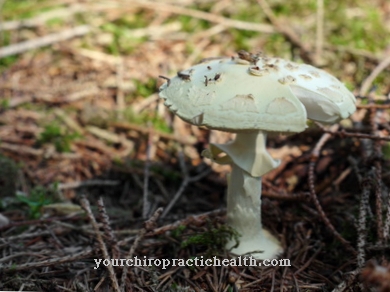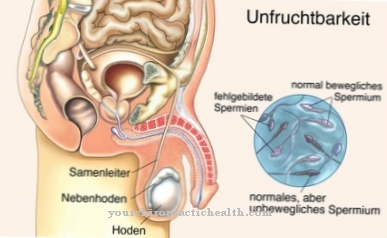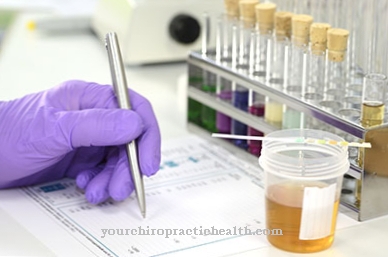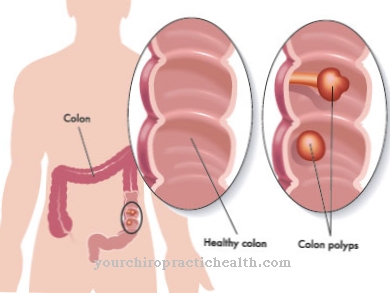As Salpingitis is an inflammation of the female fallopian tubes. It mostly arises from bacterial infections.
What is salpingitis?

© Henrie - stock.adobe.com
At a Salpingitis the fallopian tubes (tuba uterina) become inflamed. It can occur in only one fallopian tube or in both fallopian tubes. Inflammation on both sides is more common. In many cases, salpingitis is accompanied by inflammation of the ovaries (oophoritis), which doctors call adnexitis.
The paired fallopian tubes, also called tubes, create an elongated connection between the uterus and the ovaries. They occur in the lower abdomen on both sides of the body. In medicine, a distinction is made between acute and chronic salpingitis. Endometritis (inflammation of the lining of the uterus) is not uncommon as part of an inflammation of the fallopian tubes.
causes
Bacterial infections are usually responsible for the development of salpingitis. These often lead to ascending inflammation. This means that the inflammation of the affected organ spreads to the neighboring body structures. In the case of salpingitis, the fallopian tubes are affected. In most cases, the disease is the result of endometritis, colpitis (inflammation of the vagina) or cervicitis (inflammation of the cervix).
But bacteria that are transmitted during sexual intercourse can also be the cause of the onset of salpingitis. These are mostly chlamydia or gonococci. Chlamydia infection primarily affects sexually active women. Another possible cause is inadequate genital hygiene, which leads to the spread of germs that are located in the anal region, such as Escherichia coli.
In rare cases, salpingitis is also caused by a doctor during a pelvic exam or treatment. The loss of the vaginal environment during menstruation is considered a risk factor, as this has a protective effect. Wearing vaginal pessaries or IUDs and surgical interventions are also beneficial. Sometimes the inflammation also spreads to the fallopian tubes via the lymph flow or blood. Inflammatory bowel disease or Crohn's disease or appendicitis are often responsible for this.
Symptoms, ailments & signs
Salpingitis is characterized by abrupt pain in the lower abdomen, which can be seen either on one side of the body or on both halves. In addition, the women affected generally feel ill and suffer from complaints such as feelings of weakness, fatigue and exhaustion. In addition, the patient's body temperature rises. Other accompanying symptoms are constipation, diarrhea, nausea, vomiting and flatulence.
If the inflammation spreads to the intestines or the urinary bladder, further symptoms threaten. This can be painful urination or pain in the pelvis. If the vagina or cervix is also infected, there is a risk of spotting and discharge. If the fallopian tube inflammation continues, the ovaries can also be affected, which leads to adnexitis.
Peritonitis is one of the particularly feared complications. The harmful germs penetrate into the abdominal cavity via the open connection between fallopian tubes and abdominal cavity and cause inflammation that can take on life-threatening proportions. Sometimes, however, salpingitis is only associated with mild symptoms or even with no symptoms at all.
Diagnosis & course of disease
To diagnose salpingitis, the attending gynecologist will perform a physical examination of the patient. He checks the right and left lower abdomen for sensitivity to pain. The fallopian tubes react extremely sensitively to pressure. If a gynecological examination is carried out, the doctor will check the vaginal region and the cervix.A smear can be taken to prove the responsible pathogen.
With the help of a sonography (ultrasound examination) water retention, abscesses in the fallopian tube area and thickening can be determined. If salpingitis is diagnosed early, the disease usually takes a positive course. The affected woman's fertility is also preserved. However, gluing the fallopian tubes is considered unfavorable.
This often leads to infertility in the sick. Following salpingitis or adnexitis, there is an increased risk of an ectopic pregnancy. Salpingitis can also take a chronic course or spread to other organs.
Complications
Salpingitis can have various complications and long-term effects. If the disease remains undetected for a long time, accumulations of pus can form in the fallopian tubes or ovaries and worsen the course of the disease. The fallopian tube inflammation can also spread from the fallopian tubes and ovaries to the peritoneum and trigger peritonitis.
There is also the risk that the germs will get into the bloodstream and cause blood poisoning. This can be life threatening. Infection with anaerobes and Haemophilus influenza pathogens is particularly dangerous. If salpingitis develops into a chronic disease, adhesions can occur as a long-term consequence. Such adhesions are often painful and can block the ovaries and uterus.
If fertilization occurs, there is a risk of ectopic pregnancy. If the fallopian tubes are completely closed, infertility is the result. Although the adhesions can be removed surgically, bleeding, nerve injuries and infections can occur. The prescribed medication causes further complications during therapy.
The antibiotics and anti-inflammatory agents used can cause side effects and interactions and sometimes also trigger allergic reactions. An ovariectomy, i.e. the surgical removal of the ovaries, can lead to a "surgically induced menopause". This is linked to hormone fluctuations and sudden menopausal symptoms such as migraines and nausea.
When should you go to the doctor?
Pain in the lower abdomen, heavy vaginal bleeding and fever indicate salpingitis, which must be clarified by a doctor. If the symptoms do not go away on their own or are accompanied by other symptoms such as pain during intercourse or back pain, it is best to consult your gynecologist. If the above symptoms occur in connection with a chlamydial infection, a doctor should be consulted immediately.
The doctor can prescribe antibiotics and give various general measures that should lead to a speedy recovery. Close consultation with the doctor is necessary during therapy, as salpingitis can cause complications that require independent treatment.
Increasing pain suggests the inflammation is spreading to the ovaries. Then inpatient treatment may be necessary. The same applies to pressure pain in the abdomen, which can indicate an abscess formation. Other contact persons are the gastroenterologist or an internist. If you have severe symptoms, you should go to the nearest hospital to be on the safe side. Comprehensive therapy using broad spectrum antibiotics should lead to a reduction in symptoms within a week.
Therapy & Treatment
As part of the treatment of salpingitis, it is important to improve the symptoms and to preserve the functionality of the fallopian tubes. The disease is usually treated in a clinic. The patient receives antibiotics such as ceftriaxone, doxycycline, metronidazole or amoxicillin for a period of 10 to 14 days. In the case of chlamydial infection, tetracyclines or macrolides are given.
If an anaerobic infection is suspected, the therapy often consists of the administration of metronidazole and anti-inflammatory drugs. Treating the partner is also considered useful. To combat the pain, the patient is given non-steroidal anti-inflammatory drugs such as diclofenac or ibuprofen. If conservative treatment of acute salpingitis does not improve, laparoscopic surgery may be necessary.
An abscess puncture or a drainage of the Douglas space are performed. A salping tectomy and hysterectomy are also possible for older women who no longer have family planning. Sometimes an ovariectomy is also performed. Even with the chronic form of salpingitis, surgery is often required. However, the therapy results often turn out to be disappointing.
prevention
To prevent the development of salpingitis, the use of condoms is recommended during sexual intercourse. In addition, strict sexual hygiene should always be guaranteed. This can help reduce the risk of salpingitis.
Aftercare
Follow-up care for salpingitis takes place after the inflammation of the fallopian tubes has cured. It usually takes two to three weeks for the symptoms to subside completely. Then the doctor must be consulted again, who can clarify the symptoms and discharge the patient. If there are no complications, no further examinations are indicated.
If the inflammation spreads to the ovaries or peritoneum, further medical examinations are necessary. Follow-up care then includes a thorough physical examination as well as a blood sample and a patient interview. In the context of the patient consultation, the risk of transmission of the causative bacterial pathogens may also be pointed out.
In particular, sexually active women who have repeatedly contracted salpingitis need to adjust their genital hygiene. In the case of repeated illnesses, information is also provided about the early symptoms of the illness. The doctor explains the associated pain so that a quick response can be made if the disease returns.
If infertility is suspected after salpingitis has been overcome, the gynecologist should be consulted. Possible scarring of the tube wall can be determined by means of CT and possibly corrected surgically. The gynecologist or internist takes care of the aftercare of salpingitis.
You can do that yourself
Salpingitis is primarily treated by a doctor. The patient must take the medication as prescribed and inform the doctor of any discomfort or unusual symptoms. In the case of abscesses or therapy failure, inpatient treatment may be necessary.
If the disease progresses positively, general measures such as drinking enough and avoiding sexual contact apply. The abdomen can be treated with moist, warm compresses in case of pain. It is also important to ensure regular bladder and bowel emptying. In the case of an antibiotic illness, the intake of antibiotics is necessary. Then, in particular, protection and avoidance of cold and other stimuli on the immune system are important. Affected women should discuss the individual measures with their gynecologist. If the salpingitis is detected early and adequately treated, it should clear up within seven to ten days.
With a complicated course of treatment, skin changes may occur. These can also be treated with home remedies. Aloe vera is ideal for redness and itching. Chamomile compresses from the household can help. Homeopathy also offers various globules. Homeopathic remedies should only be taken in consultation with the doctor.




.jpg)







.jpg)



.jpg)










.jpg)
